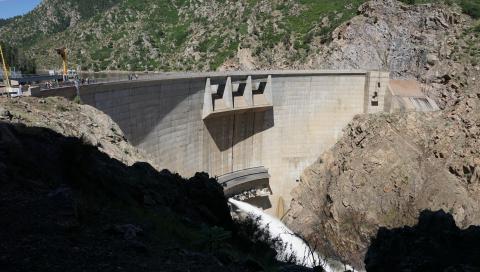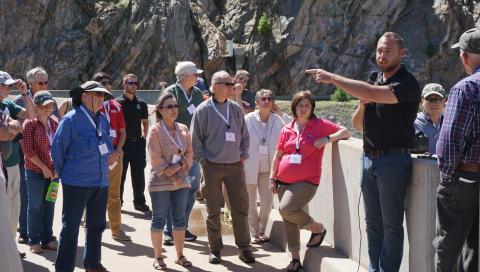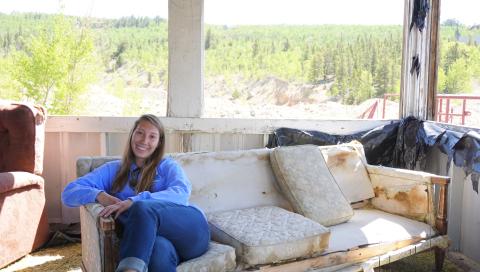By: Jasmine Mausbach, Intern at Water for Food Global Institute
The 2016 water and natural resources tour, hosted by the Nebraska Water Center and the Central Nebraska Public Power and Irrigation District, took place June 14-16 in Colorado's central Front Range area and into the interior of the Rocky Mountains. The annual tour examines local and regional water issues, including agricultural water use, water management, water quality and environmental impacts.
A nine-hour drive to Denver, Colorado on two-lane blacktop is how my journey began for this summer’s three-day annual water and natural resources tour. Although the drive through central and western Nebraska was interesting to say the least, it paled in comparison to the Rockies of Colorado. Our first stop on the tour took us to the base of those fabled mountains, to the Kassler Center in Littleton. At this stop, Matt Bond from the Denver Water Board spoke about municipal water for the Denver area. Interestingly enough, most of the water used in Denver comes from the western side of the Rockies, which creates a rift between the “Front Range” and “West Slope.” Denver’s water use has also put a strain on the relationship between Colorado and Nebraska concerning flows in the South Platte River. With a population growing by about 18,000 people per year, Denver is using more and more water each year, which means less water is making its way down the South Platte to Nebraska. Recently though, Denver has worked to reduce its consumptive water use through concerted efforts at conservation and efficiency, despite issues facing Denver water supply. Despite growth, climate change and a diminishing Colorado River are other such issues.
That same day, Nicole Seltzer and Sean Cronin from Colorado Water Education Foundation and St. Vrain & Left Hand Water Conservancy District respectively, spoke to the tour group while we enjoyed lunch at the former capitol building, Old Capitol Grill in Golden. The highlight of the day ended with a tour of the Miller Coors Brewery in Golden, where I learned about the use of water in brewing beer.
The following day began with a bus ride to the Rocky Mountain Research Station in the U.S. Department of Agriculture’s Fraser Experimental Forest. Chuck Roades, a research biochemist for the U.S. Forest Service, spoke about the impact the native mountain pine beetle outbreak has had on the health of the forests in the area. In 2008, an infestation of mountain pine beetles occurred across several forested areas in the Rocky Mountain range, decimating almost 90 percent of all lodgepole pines in Colorado, many of which are still standing. The Rocky Mountain Research Station has been conducting experiments that study the impact the beetle infestation on lodgepole pines has had on the overall watershed of the area. They have found that with the dead trees still standing and with a lack of foliage, water seepage, mainly from snowmelt, into the watershed has increased, which in itself is good news. More seepage into the watershed translates to less water loss from evapotranspiration and more water for multi-purpose uses for Colorado. It also means potentially more water flowing into the South Platte that flows into Nebraska, which can be utilized by Nebraska producers to irrigate crops or replenish surface and groundwater supplies.
The last stop of the day involved whitewater rafting down Class 4 rapids on Clear Creek at Liquid Descent Whitewater Rafting Co. near Idaho Springs. There are only six classes of rapids, with Class 6 rapids equivalent to those of Niagara Falls. It was by far the most life threatening stop of the tour, but I am happy to report that no one fell overboard and due to our hospitableness, employees at Liquid Descent were left with a very good impression of we flatlanders from Nebraska.
On the last day of the tour, the day began bright and early with breakfast presentations by Ray Weller and Rick Cables from Vail Resorts, Inc. Weller educated the group about the snow-making process at Breckenridge Ski Resort and how they use water from the Blue River to make snow. Cables talked about the environmental mitigation activities with the U.S. Forest Service and how it related to water usage within and around Breckenridge. After breakfast, the next stop allowed the group to inspect a massive and historic gold/silver-mining dredge near Fairplay. Joanna Hopkins from Maryland Creek Ranch, who owns the 483-ton, 75-year-old dredge, spoke about its history and how water was used to clean thousands of tons of material that was run through the dredge in search of the gold and silver found in the area.
Traveling back east, over the Continental Divide, the group was treated to lunch at Kenosha Steakhouse in Breckenridge where Troy Wineland, Water Commissioner for the Blue River Watershed, talked about water rights conversions and transfers in the Blue River watershed. The final stop of the tour brought the group to a dredge-mining reclamation site adjacent to Swan River, where we learned about the work being done to restore the native stream that once flowed through the land before the dredge-mining industry covered up the stream with waste material.
Lastly, I want to give special recognition to the following groups: Nebraska Water Center; the University of Nebraska-Lincoln’s Institute of Agriculture and Natural Resources; The Central Nebraska Public Power and Irrigation District; Nebraska Public Power District; Robert B. Daughtery Water for Food Global Institute; Lower Platte North Natural Resources District; LI-COR Biosciences; and Nebraska Water Balance Alliance (NEWBA). Without these sponsors and their contributions, this year’s tour wouldn’t have been possible, and I wouldn’t have had the opportunity to experience Colorado water at such an in-depth scale.
The Nebraska Water Center co-sponsors water and natural resources tours annually, in and outside of Nebraska. Keep updated by checking the Nebraska Water Center website or following them at @NebrWaterCenter. View photos from the tour.



